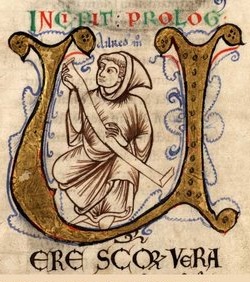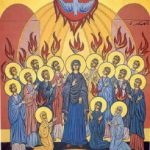All Saints
Today we mark All Saints’ Day, as a feast moved from the 1st of November.
If we had kept this feast on that day, we would have been in the midst of a strange season sometimes called Allhallowtide—the period beginning at All Saints’ Eve, or Halloween (All Hallow’s Eve). I’m sure you know it from its ghoulish costumes, trick-or-treating, and Jack-o-lanterns.
On All Saints’ Day, the Church remembers all its saints, known and unknown. We remember all who have achieved union with God or, as we sometimes say, who have achieved glory and the beatific vision.
We remember, too, that we are indeed on a way. Life has a goal and a trajectory, and is not a meaningless sequence of happenings.
 Human beings are wayfarers, beings on the way to God. And sainthood is, actually, the goal of life. In the early medieval view of salvation, we ascend to God, as if climbing a great mountain: sometimes we gain a higher foothold and sometimes we slip.
Human beings are wayfarers, beings on the way to God. And sainthood is, actually, the goal of life. In the early medieval view of salvation, we ascend to God, as if climbing a great mountain: sometimes we gain a higher foothold and sometimes we slip.
The secret of moving higher is not to focus on ourselves, for then we become stuck or nervous or self-absorbed, and we make unwise choices. We fall into sin, and go hurtling down and down. No, we must look upwards towards the sun, if we can bear the vision of it through our squinting eyes. We must try to forget ourselves and our frailty, becoming accustomed to the light from which we draw all our resource. Somehow, seemingly by a life and power beyond ourselves, we make it to the next foothold. And as we become more and more used to the light of the sun, we can look upon it more easily.
When we forget ourselves and look around, we see the whole mountain, illuminated by the sun with its many climbers. They offer us their help; they warn of dangerous footfalls, the stones that are loose and that spin away to the earth. And we ourselves offer what help we can to those below us. We throw out some ropes; we lend a hand.
 The higher we climb, strangely, the more helpful the climbers around us seem to be: they are adepts. They have become good climbers, and most cooperative. It is not like it was at the beginning, when all those brazen and competitive climbers tried to outdo one another, some of them even jumping on the backs of others: they didn’t make it.
The higher we climb, strangely, the more helpful the climbers around us seem to be: they are adepts. They have become good climbers, and most cooperative. It is not like it was at the beginning, when all those brazen and competitive climbers tried to outdo one another, some of them even jumping on the backs of others: they didn’t make it.
Distantly we can see some who have made it to the top. These are related to everyone below, bestowing their friendship and wisdom on all. They are skilled at cooperating one with another: they seem to be even a single person—going out of themselves ecstatically. They are a communion, holding all things in common. And these fully enlightened ones are the saints. In their midst is the Christ, who shines with the lustre of the sun. His life is fully communicable to all; he is friend to all.
The ascent to God that I have been describing is the way of love, of caritas or agape. It is the way of self-forgetfulness and cooperation with others, which brings within it wisdom. And this is the goal of life. Love, or friendship, and wisdom are the highest goods–and not riches, or honours, or food or sex for their own sake.
And this was exactly the early medieval view of salvation.
Yet, as we know, this teaching grew corrupt. In the time of Martin Luther, some were suggesting that, after all, we could buy our way to the top. Some imposed harsh disciplines which did not make us better people, but only made us more fearful and selfish. Drawing no strength from the sun above, we became utterly exhausted. We forgot that growth in love was the point of the climb.
Some of the reformers tried to abolish the mountain altogether. None were higher or lower, they said. If we had trust in God, we were already saints—all of us who are in Christ, and not just some on the mountain top. All ideas of progressive ascent or rising were to be abolished, including the idea of a continual purification after death. For a while, this gave a great sense of release: a great sense of freedom and equality. There was a level playing field.
 But as the initial enthusiasm died down, the way of salvation still seemed unsure: was there really nothing to strive for? Was there no Way?
But as the initial enthusiasm died down, the way of salvation still seemed unsure: was there really nothing to strive for? Was there no Way?
And, sadly, there came new prophets, proclaiming the way of selfish and competitive struggle—for money, for sex, and for power. The vision of the Light that bestows love and wisdom was eclipsed. The dark clouds loomed thickly over the mountain, and few rose above the foothills.
Yet the mountain of God remains. And in the faith of the Church, Christ will suddenly shine forth as the goal of history.
Behold, he comes with clouds; and every eye shall see him, and they also who pierced him: and all tribes of the earth shall wail because of him.
The Way will be revealed in our midst: and that will be a great day of truth and judgement. The measuring line will fall. And the values of the world will be overthrown.
And on the great feast of All Saints’ we remember all these truths. We especially remember all who are dear to us, who have participated in the Light, who have bestowed light, and who are moving towards the Light.
Rest eternal grant to them, O Lord, and let light perpetual shine upon them.

